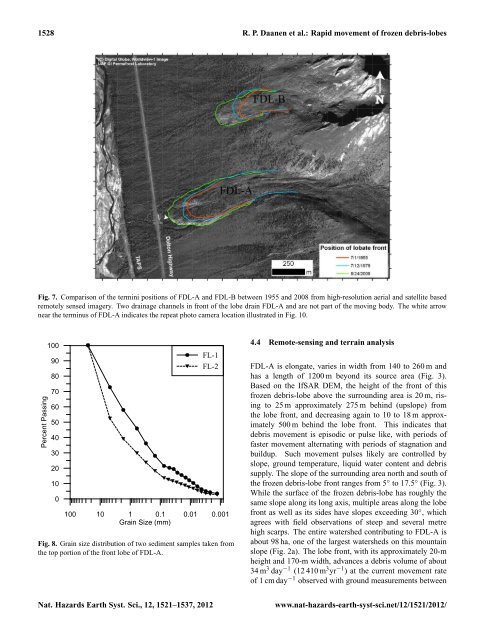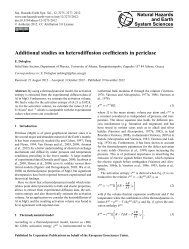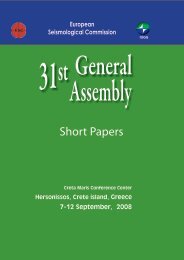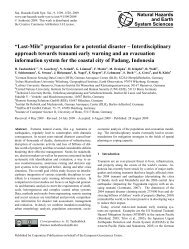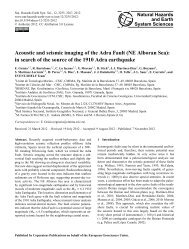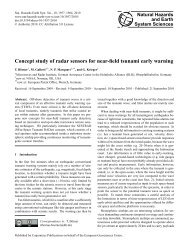implications for permafrost degradation and slope instability in the ...
implications for permafrost degradation and slope instability in the ...
implications for permafrost degradation and slope instability in the ...
You also want an ePaper? Increase the reach of your titles
YUMPU automatically turns print PDFs into web optimized ePapers that Google loves.
1528 R. P. Daanen et al.: Rapid movement of frozen debris-lobes<br />
1<br />
Fig. 7. Comparison 2 Figure of <strong>the</strong> 7.Comparison term<strong>in</strong>i positions of of <strong>the</strong> FDL-A term<strong>in</strong>i <strong>and</strong>positions FDL-B between of FDL-A 1955 <strong>and</strong> 2008 FDL-B frombetween high-resolution 1955 <strong>and</strong> aerial2008 <strong>and</strong> satellite based<br />
remotely sensed imagery. Two dra<strong>in</strong>age channels <strong>in</strong> front of <strong>the</strong> lobe dra<strong>in</strong> FDL-A <strong>and</strong> are not part of <strong>the</strong> mov<strong>in</strong>g body. The white arrow<br />
near <strong>the</strong> term<strong>in</strong>us 3 from of FDL-A high-resolution <strong>in</strong>dicates <strong>the</strong>aerial repeat<strong>and</strong> photo satellite camerabased locationremotely illustratedsensed <strong>in</strong> Fig. imagery. 10. Two dra<strong>in</strong>age channels<br />
Percent Pass<strong>in</strong>g<br />
100<br />
90<br />
4<br />
5<br />
<strong>in</strong> front of <strong>the</strong> lobe dra<strong>in</strong> FDL-A <strong>and</strong> are not part of <strong>the</strong> mov<strong>in</strong>g body. The white arrow near <strong>the</strong><br />
term<strong>in</strong>us of FDL-A <strong>in</strong>dicates <strong>the</strong> repeat photo camera 4.4 location Remote-sens<strong>in</strong>g illustrated <strong>and</strong> <strong>in</strong> figure terra<strong>in</strong> 10. analysis<br />
FL-1<br />
FL-2<br />
80<br />
FDL-A is elongate, varies <strong>in</strong> width from 140 to 260 m <strong>and</strong><br />
has a length of 1200 m beyond its source area (Fig. 3).<br />
70<br />
Based on <strong>the</strong> IfSAR DEM, <strong>the</strong> height of <strong>the</strong> front of this<br />
frozen debris-lobe above <strong>the</strong> surround<strong>in</strong>g area is 20 m, ris-<br />
60<br />
<strong>in</strong>g to 25 m approximately 275 m beh<strong>in</strong>d (up<strong>slope</strong>) from<br />
<strong>the</strong> lobe front, <strong>and</strong> decreas<strong>in</strong>g aga<strong>in</strong> to 10 to 18 m approx-<br />
50<br />
imately 500 m beh<strong>in</strong>d <strong>the</strong> lobe front. This <strong>in</strong>dicates that<br />
40<br />
debris movement is episodic or pulse like, with periods of<br />
faster movement alternat<strong>in</strong>g with periods of stagnation <strong>and</strong><br />
30<br />
buildup. Such movement pulses likely are controlled by<br />
20<br />
<strong>slope</strong>, ground temperature, liquid water content <strong>and</strong> debris<br />
supply. The <strong>slope</strong> of <strong>the</strong> surround<strong>in</strong>g area north <strong>and</strong> south of<br />
10<br />
<strong>the</strong> frozen debris-lobe front ranges from 5<br />
0<br />
100 10 1 0.1<br />
Gra<strong>in</strong> Size (mm)<br />
0.01 0.001<br />
33<br />
Gra<strong>in</strong> size Fig. distribution 8. Gra<strong>in</strong> size of two distribution sediment of two samples sediment taken samples from taken <strong>the</strong> from top portion of <strong>the</strong> front<br />
L-A. <strong>the</strong> top portion of <strong>the</strong> front lobe of FDL-A.<br />
◦ to 17.5◦ (Fig. 3).<br />
While <strong>the</strong> surface of <strong>the</strong> frozen debris-lobe has roughly <strong>the</strong><br />
same <strong>slope</strong> along its long axis, multiple areas along <strong>the</strong> lobe<br />
front as well as its sides have <strong>slope</strong>s exceed<strong>in</strong>g 30◦ , which<br />
agrees with field observations of steep <strong>and</strong> several metre<br />
high scarps. The entire watershed contribut<strong>in</strong>g to FDL-A is<br />
about 98 ha, one of <strong>the</strong> largest watersheds on this mounta<strong>in</strong><br />
<strong>slope</strong> (Fig. 2a). The lobe front, with its approximately 20-m<br />
height <strong>and</strong> 170-m width, advances a debris volume of about<br />
34 m3 day−1 (12 410 m3yr−1 ) at <strong>the</strong> current movement rate<br />
of 1 cm day−1 observed with ground measurements between<br />
Nat. Hazards Earth Syst. Sci., 12, 1521–1537, 2012 www.nat-hazards-earth-syst-sci.net/12/1521/2012/


